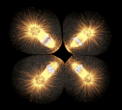George von Dassow

The transformations by which tissues and organs emerge in embryos come about by coordinating the behaviors of individual cells. Active cell shape change, in turn, emerges from the interaction between self-assembly of the cytoskeleton and the cell’s external environment, especially its neighbors. So that’s how I see an embryo when I look at it through the microscope: it’s a network of deformable packages in which polymers grow and shrink, motors crawl along those polymers, contractions reshape the cell surface or move organelles, and so on. My research focuses on cell division in early invertebrate embryos, when cells are large, have little else to do besides divide, and don’t grow between divisions.
The act of division itself – cytokinesis – is probably the single most complicated mechanical act an animal cell ever performs on its own. To pinch itself in two, the cell first has to sort replicated chromosomes, then figure out where its middle is, assemble contractile proteins at the cell surface around that equator (and nowhere else), then squeeze the equator smaller and smaller to partition surface, organelles, and cytoplasm into two new daughter cells. Finally the daughters have to sever their connection and re-establish their own internal organization. Throughout cytokinesis, the cell has to ensure that each half of itself will end up with a complete set of chromosomes, one microtubule organizing center apiece, and of course portions of every other organelle.
It remains deeply mysterious how animal cells do all of this, while making errors rarely enough to concoct viable organisms that consist of myriad cells. Currently I am preoccupied with the central pattern-formation event: cleavage plane specification, during which the cell surface learns where it has to contract in order for the division to pass between the separated chromosome sets. To study these events I rely mainly on embryos of sea urchins and other echinoderms, whose large, relatively clear cells can be easily injected with fluorescent probes to reveal the structure and behavior of the cytoskeleton. You can see more about current projects on the “Research” page; please also check out my recent publications if you’d like to learn more.
I’m a senior research associate at the OIMB, where I share space with my wife Svetlana Maslakova in her lab. I don’t have graduate students, and work primarily with collaborators elsewhere, but my research, which is currently funded by the National Science Foundation, offers a variety of opportunities for undergraduate students. I’m also eager to collaborate with scientists visiting the OIMB for research on embryology and microscopy.

Cell Behavior during Animal Development
Write to me at:
OIMB
PO Box 5389
Charleston OR 97420
See also:



Please Note:
All images and movies on these pages belong to George von Dassow unless noted otherwise; you are welcome to use them informally (e.g., in talks or lectures) as long as you give me credit, but please do not reproduce anything elsewhere, including on the web, without my explicit permission.

